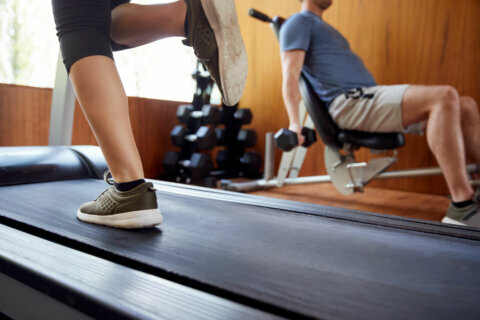
Editor’s note: Dana Santas, known as the “Mobility Maker,” is a certified strength and conditioning specialist and mind-body coach in professional sports, and is the author of the book “Practical Solutions for Back Pain Relief.” You can read her CNN series on how to reboot your workout routine here.
When it comes to 2020, one of the big positives to emerge from this year’s many challenges is how it has focused our attention on prioritizing health and wellness — with a particular emphasis on physical fitness.
To meet our fitness needs while gyms were closed for prolonged periods, many of us started working out at home. Some got creative, using household items for our workouts, while others ordered home gym equipment online. Now, after getting a taste of at-home training, more people are considering making it a permanent practice.
If you’re currently weighing the benefits of creating a dedicated space for your own home gym and wondering how you can make it work for your lifestyle, read on.
Consider the benefits of working out at home
As a mind-body coach in professional sports who also has a garage gym, I can attest to numerous advantages of at-home training. Of course, with current Covid-19 concerns, a huge benefit is the knowledge that your home gym is virus free and kept up to your own cleanliness standards.
But there are many other positive aspects, including the following:
- Enjoying ease of access and time efficiency. With no travel time and no closing time associated with your home, it’s hard to make the common time-related excuses not to exercise. Additionally, your training time can be more efficient as you don’t have to wait your turn for equipment or spend extra time on your workout to rationalize the commute or cost.
- Shifting your training perspective from a chore to a lifestyle. Because the gym is part of your home, training becomes part of your lifestyle rather than another to-do outside of the house. This creates a sense of ownership of your fitness, instilling it as a healthy lifestyle habit rather than an obligation.
- Shedding insecurities and relishing quality time. Without having to feel self-conscious about others judging you during workouts in a public gym, your home gym time is of a higher quality, letting you focus entirely on you and your goals. And, if you have a spouse or family, training together can be a quality bonding experience.
With all the benefits, it might be tempting to stop reading and immediately go convert a guest room or start cleaning out your garage to make space. But continue on for tips to ensure that the space you designate for working out will actually work for you.
Gauge the scope of your space based on an accountability — not future goals
It’s easy to tell ourselves that if we have a home gym, we’ll work out all the time.
But, if you haven’t already established a track record of working out regularly, I’d advise you to start your journey slowly, building momentum based on accountability.
While my garage gym is now fully equipped, that hasn’t always been the case. My commitment to training at home was an evolution that started small. In fact, several years ago, my “home gym” was nothing more than a crate holding a kettlebell, two small dumbbells, a yoga mat, foam roller and a few mini tension bands.
It was only as my training consistently expanded that I committed to a dedicated space. Over the course of a year, that meant using space on the lanai before moving into half of our garage, then finally turfing the entire garage and purchasing more equipment.
After several years of consistently using our two-car garage gym setup, this past February, my husband and I purchased a new home with a three-car garage so that we could convert the larger garage into our gym space.
It was a big commitment! But we had no doubt we were ready for it because we had established a foundation of accountability. You can do the same at whatever scale is appropriate for you.
Select a space that won’t disrupt your lifestyle
Your home should be your sanctuary. That’s why I’m not advocating that you turn your home into a gym. It’s about ensuring your home still retains all the features you love while accommodating a dedicated workout space that you’ll also love.
Whether you designate a guest room, garage or basement, be thoughtful about the relocation of items from that space. If something in it was seldom used, but out of the way, and you’re forced to move it to a high-traffic area, like a hallway, that’s a disruption. If frequently used items get relegated to a closet or high shelf, that’s also a disruption.
The garage made the most sense for us because we don’t mind parking our cars in the driveway. And we were able to reorganize and relocate everything else from the garage by purchasing a backyard storage shed, wall bike rack and garage ceiling storage mounts.
However, if you covet your car, displacing it to create a gym in your garage probably won’t make sense for you. Instead, you might consider converting a seldom-used dining room into a home gym by putting a bigger table in your eat-in kitchen area. Or maybe you have a guest room that is rarely used. Could you dedicate that space to a home gym if you upgraded your living room sofa to a sleeper to avoid losing the ability to host guests?
To effectively create a home gym that integrates into your lifestyle, you need to think through the utility of the space you’re considering converting and create an acceptable, practical plan for relocating items and repurposing other areas as necessary.
Design your space to be a place where you want to spend time
Designing your workout space based on your likes sounds like a no-brainer. However, when it comes to fitness, we tend to focus on what we think we should like or do, not how we actually feel and act. Just like my advice for gauging the scope of your gym space, this is a reality check. Create your space based on how you feel and what you do now.
Do you enjoy lifting weights more than doing cardio? Create a space that facilitates strength training. If it’s the other way around, design your space as such.
According to Cooper “Coop” Mitchell, the founder of GarageGymReviews.com, when people are designing their home gym, they often overlook essential elements that contribute to making the environment comfortable.
“Design a space where you’ll want to spend time,” Mitchell advised. “That means, not only focusing on the equipment, but also putting thought into things like lighting, flooring and your sound system.”
If your workout space is not climate controlled, like a three-season porch or garage, I would also advise figuring out heat and AC options. This year, we invested in a portable air conditioner to temper the heat and humidity in our Florida garage gym.
Prioritize equipment spending based on preferences, quality, goal setting and versatility
Start by determining your realistic budget, and don’t worry if you don’t have a lot of money to spend up front. Remember the crate I started with? The items within it were just enough to create a well-rounded program that fit my needs. You can accomplish a lot with a set of dumbbells, a kettlebell, mat, foam roller and mini bands.
Even with a decent budget, you don’t want to invest in items you’ll rarely use. Take your spending cues from your own preferences. If you favor cardio over weight lifting, invest in a solid piece of cardio equipment, like a rower, indoor bike or elliptical — selecting the specific equipment based on the type of cardio you enjoy and propensity for regular use.
Before you tackle weight lifting, Mitchell advised purchasing a quality barbell. “A good barbell may cost upward of $300 but that should ensure you’re getting a quality, made-in-America product with a lifetime warranty,” he said. “And, if you can afford it, spending your money on a decent entry-level squat rack is a great investment since they tend to retain their value and can be resold on Craigsist or Facebook Marketplace, if you ever change your mind or want to upgrade.”
When determining the right brand of any type of equipment, practice due diligence and look up reviews. With most fitness equipment, you can find in-depth reviews on YouTube.
Just like you would decorate any other part of your house, you might find yourself wanting to get all the latest training tools for your home gym. Although it’s good to add some novelty here and there to keep things fresh and interesting, overloading your home gym can make it less functional.
One of the best ways to curtail this tendency, while also reinforcing your training habit, is to tie a new product purchase to achieving a fitness goal. For instance, training five days a week for eight consecutive weeks could serve as an equipment-purchase milestone.
As someone who has successfully maintained my own home gym for years, I can tell you that the benefits never abate and only increase. If you follow the advice I’ve outlined above, you can create a home gym that will work for you, forging a commitment to health and wellness that complements your lifestyle.








